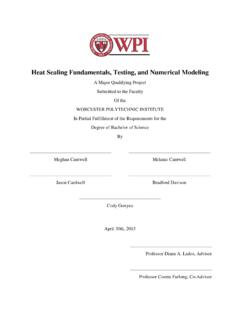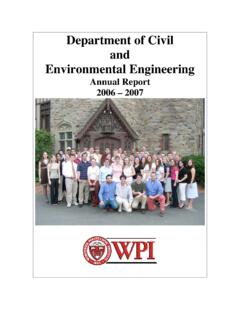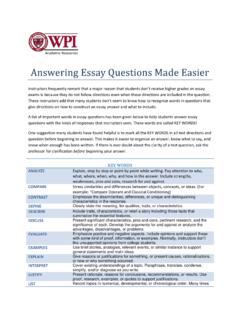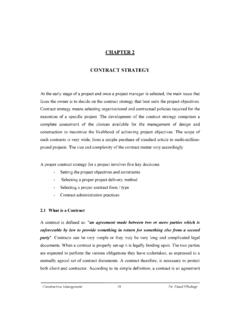Transcription of Smart Door Lock - Worcester Polytechnic Institute
1 MQP MXC - 0580 Smart Door Lock MAJOR QUALIFYING project Submitted to the Faculty of Worcester Polytechnic Institute in partial fulfillment of the requirements for the Degree in Bachelor of Science Authors: Aleksander IBRO Augusto WONG Mario ZYLA April 28, 2019 This report represents work of WPI undergraduate students submitted to the faculty as evidence of a degree requirement. WPI routinely publishes these reports on its web site without editorial or peer review. For more information about the projects program at WPI, see project Advisors: Michael CIARALDI Maqsood MUGHAL i Abstract Smart Door Lock Major Qualifying project The goals of this project were to build a modern, easy-to-use, Smart door lock that allows for accessible unlocking and adds convenience, utility, and security to your home.
2 It allows users to open their door remotely via the accompanying Smart Lock mobile app, or hands-free by using face recognition via a camera mounted on the door. The system was made up of three major components, including a cloud back-end, an on-board logical unit, and a mobile application. ii Acknowledgments We thank our MQP advisors professors Michael Ciaraldi and Maqsood Mughal for guiding us throughout the project , and for their great flexibility on agreeing to make this project an actual MQP. iii Executive Summary The goal of this project was to provide an easy and convenient method for unlocking a front door by removing the need for the old-fashioned key. We start by evaluating the need for such a system by sending a survey and analyzing the results. We follow the Software Development Life Cycle to set the project objectives and implement the design.
3 The project has three main components: a Raspberry Pi, a cloud backend, and a mobile application. The Raspberry Pi is attached to the door and is responsible for controlling a servo motor, a camera, and an actuator. Users can open the door by either tapping a button on the mobile app, or just by approaching the door. When a user is within a certain radius, a PIR sensor detects them, and activates the camera. The Raspberry Pi then sends an image of the user at the door to the backend server. The server is a Python Flask application hosted in Azure Cloud Services. It seamlessly runs a face recognition library, which compares each image sent by the Raspberry Pi with images already uploaded in the Cloud. If the face recognition algorithm identifies a face in that image, it automatically sends a positive response to the Raspberry Pi, which in turn activates the actuator and opens the door.
4 The Azure backend is also responsible for serving requests coming from the mobile application, like storing images of users faces, tapping a button to open the door, or saving each user s personal information. Azure App Services is a feature of Azure, which makes it easy to quickly deploy a cloud application. The Smart Lock app is the forefront of the system, providing an intuitive User Interface. From this app, users can not only manage their accounts, but also add friends and family by simply providing their names and photos of their faces. Once a friend is added, the face recognition library will be able to identify them, and, if provided with access by the user, automatically unlock the door via the Raspberry Pi. To make sure that you don t have unexpected guests, you can pick the days and times that your friends can get in. You can also opt in for a push notification that will let you know whenever someone is at the door.
5 From the Smart Lock app, users have access to a livestream of their front door. This feature allows users to let their guests in with a simple tap of a button, even if these guests haven t been added beforehand. Furthermore, users can keep track of everyone using the system with a dedicated view that shows every action performed on the door, including the time and day of the action, as well as the person performing it. Our project integrates a board computer like the Raspberry Pi, a Cloud backend provided by Microsoft s Azure, and a mobile application built in Swift. These three components come together to create a seamless and convenient way for you and your family to control the doors of your home. Now you don t have to worry about losing your key, getting locked out, or having your hands full with groceries, because the Smart Lock system has you covered.
6 Iv Table of Contents Abstract i Acknowledgments ii Executive Summary iii Table of Contents iv List of Figures vi List of Tables vii 1 Background 1 Internet of Things 1 Access Control Credentials and Readers 1 Keypads 2 Access Cards and Card Readers 2 Biometric readers 2 Smart Door locks 3 August Door locks 3 Kwikset Kevo locks 4 2 Methodology 5 Introduction 5 Why We are Choosing this Strategy 5 Requirements Gathering 5 Survey 6 Analysis 6 Design 6 Platform Choice - Mobile Websites vs. Mobile Applications 7 Platform Choice - iOS vs. Android 7 Platform Choice - Raspberry Pi vs. Arduino 8 Platform Choice - Motion Sensor Ultrasonic vs PIR 10 Ultrasonic Sensor 10 PIR Sensor 10 Platform Choice - Actuator 11 Pneumatic Actuators 11 Hydraulic Actuators 12 v Electric Actuators 12 System and Object Design 13 UML Class Diagrams 13 Components Diagrams 14 State Machine Diagrams 14 Implementation and Testing 15 First Component - Smart Lock App 16 Second Component - Raspberry Pi 17 Third Component - Cloud Backend 19 Azure Virtual Machine (VM) in the Cloud 19 Azure SQL Database 20 Azure App Services 21 Google s Firebase Authentication 21 3 Results and Conclusions 22 Future Work 22 Appendix A: User Manual 23 Getting Started 23 Adjust your Settings: Account Tab 23 Who is at the door: Home Tab 24 Add Friends: Guests Tab 25 Add Admins: Guests Tab 26 Check who has been at your door.
7 Activity Tab 27 Appendix B: User Stories 28 Appendix C: Survey Results 29 Bibliography 31 vi List of Figures Figure Keypad Access Reader ..2 Figure Card Reader ..2 Figure Biometric Reader ..2 Figure Activity View for August App ..3 Figure August Door Mount ..3 Figure Kwikset Kevo Lock ..4 Figure Software Development Life Cycle Phases ..5 Figure High-level class diagram of the Smart Lock main objects ..13 Figure Components Diagram ..14 Figure State Machine Diagram for the Smart Lock system mounted on the door ..15 Figure The three main components of the Door Lock System ..16 Figure Electrical Schematic of the Smart Door Lock device ..18 Figure The upload_image route that runs in the Flask server when an image is sent from RPi ..20 Figure Entity Relation Diagram for the app ..20 Figure Comparison of adding a new Friend to the DB using the Flask Server (left) and using the App Services (right).
8 The Flask server code (bottom left) is completely gone after migrating to App Figure Smart Door Lock system mounted on a mockup door ..22 vii List of Tables Table 2-1 Comparison between a website and a mobile app [11] ..7 Table 2-2 A Comparison of React Native Pros and Cons [12] ..8 Table 2-3 A comparison between Raspberry Pi and Arduino Uno [13] ..9 Table 2-4 A comparison between an ultrasonic and a PIR sensor ..11 Table 2-5 A comparison among a pneumatic, hydraulic, and electric actuators ..12 Table 2-6 Smart Lock App features submitted in proposal. Underlined features were not implemented ..16 1 1 Background In this chapter, we begin by introducing the Internet of Things, continuing with a discussion of the inclination people have shown toward IoT devices, and how different door access control systems have adhered to or missed the population s needs.
9 We show examples of some products designed to offer a much needed convenience to door lock systems. Internet of Things In the last few years, the Internet of Things (IoT) has attracted attention from both academic and industrial worlds. IoT is a concept describing a vision in which everyday objects are connected to the Internet, are identified, and communicate with other devices [1]. These interconnected devices are referred to as Smart devices. Each of these Smart devices is a physical component with communication functionality, possessing a unique identifier, some basic computing capabilities and a way to react to different physical phenomena around them [2]. From a global IoT market perspective, the population of IoT devices will reach about 26 billion by 2020, up from only 900 million in 2009 [2]. The most common examples of Smart devices are wearables like watches.
10 Smart watches such as the Apple Watch and Fitbit have penetrated the market not very long ago. Such devices have also entered our homes with products such as Amazon Echo, a voice assistant, which users can talk with to play music, provide weather, and control other IoT devices. A less common example can be seen in Barcelona, where the city has implemented some IoT initiatives that have helped enhance Smart parking [3]. An exponential growth is expected for the IoT market and an increasing number of Smart devices show the inclination of the industry toward offering these interconnected solutions to increase convenience, but also the high adoption rate of the population [4]. Access Control Credentials and Readers We have researched a few access control methods that are currently being used around the world. In this section, we will explain three of the most prevalent types, focusing on their advantages and disadvantages.

















